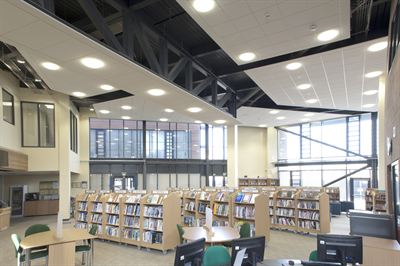Acoustic camouflage: Active materials beat building noise

Is noise an architect's problem?

Architectural Testing, Inc. (ATI), which tests building products, is investing in the trend.
Last week they opened a new testing facility among the Amish farms of York, Pa., for testing of complex horizontally-oriented systems, says Eric Miller, ATI's director of acoustics, rather than vertically oriented sound reverberation, such as through walls, which are commonly tested.
That means better testing of construction materials and systems like ceiling tiles, pipe lagging systems, skylights, roof assemblies and floor and ceiling systems, which dramatically affect interior sound levels.
Cork it
New ideas for horizontal surfaces include novel "acoustic rafts" made by Ecophon (part of Saint-Gobain), and composite sandwich materials using cork as a core material, rather than synthetic foams.
Jonghwan Suhr at the University of Delaware's Center for Composite Materials (CCM) says cork is an ideal core material for enhanced noise mitigation.
Compared with foam, "We achieved a 250 percent improvement in damping performance using the cork-based materials," CCM's Suhr says. "Further, cork radiates little to no noise and is inexpensive and environmentally friendly.
Mask and cancel
The technology side is fun. This so-called "active" side of acoustics includes tried-and-true approaches like public address audio, white noise played through speakers, and "soundfield systems," which actually amplify noises such as a speaker's voice in a convention hall or lecture room. (One maker is called SoundField Systems, based in the U.K.)
But architects see sound masking and noise-cancellation gadgets as a band-aid, for use when a building has failed, acoustically speaking. Better yet are walls, windows and ceilings that block sound with novel materials and clever, noise-isolating details -- collectively known as passive acoustic systems.
Yet on the frontiers of research, "passive" acoustic techniques are getting more and more active.
Materials that architects expect to be passive, such as air barriers or insulation, could soon also respond to changes in noise levels, wind or pressure.
The grail of these active-passive acoustical materials may be suggested by an article in Nature yesterday, which describes a way to make "self-thermoregulating nanomaterials."
Active, not passive!
Reported by a team of Harvard engineers, the nanomaterials actively respond to environmental changes to retain desired performance characteristics -- for example, pressure -- using "compensatory chemical feedback response," which gives them their active qualities.
How does that affect acoustics? Imagine a building air barrier or insulation material, for example, which could respond to changes in outdoor noise or even the weather. The dynamic materials would instantly compensate, similar to how goosebumps form on our skin when we're cold.
Using the nanomaterials platform -- called SMARTS, or Self-regulated Mechanochemical Adaptively Reconfigurable Tunable System -- a building could turn "on" when noise levels are high, and deactivate when it's quiet.
Acoustic action
The idea of acoustics as a way to actuate systems is known in HVAC systems and also ambient noise canceling. But the capabilities are way beyond what product manufacturers use today.
Earlier this month, a group of researchers at Penn State came up with an acoustic tweezers, which can trap and move tiny cells for studies of disease and such. They use ultrasound to catch and manipulate the single cells or microorganisms.
In the military, soldiers are benefiting from better ways to study "acoustical camouflage" -- the us of textile materials to absorb and suppress sound waves. The reason? Modern directional microphones, used to eavesdrop on soldiers in battle, are especially good at hearing fabric noise.
Could this feature improve building designs? According to the Hohenstein Institutes in Bönnigheim, Germany, which has experts in analyzing the acoustic properties of moving textile materials, the new test methods will help determine the suitability of a tent material or wall linings for protecting against sound waves.
The results can help reduce sound transmission through walls -- but also the potentially irritating sounds made by materials rustling or flapping due to air movement.
This post was originally published on Smartplanet.com